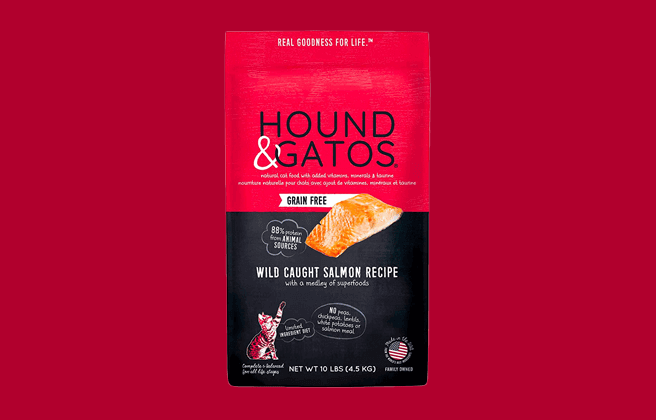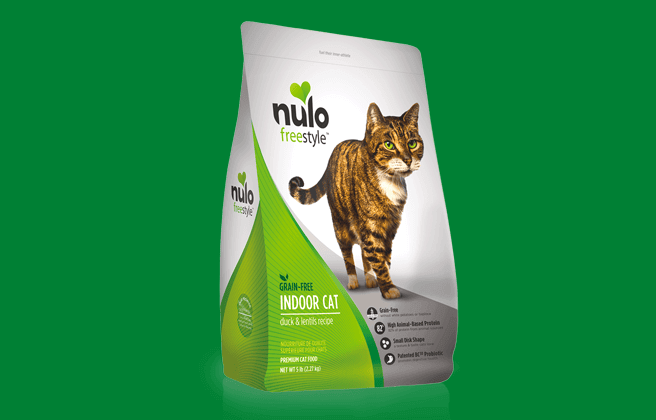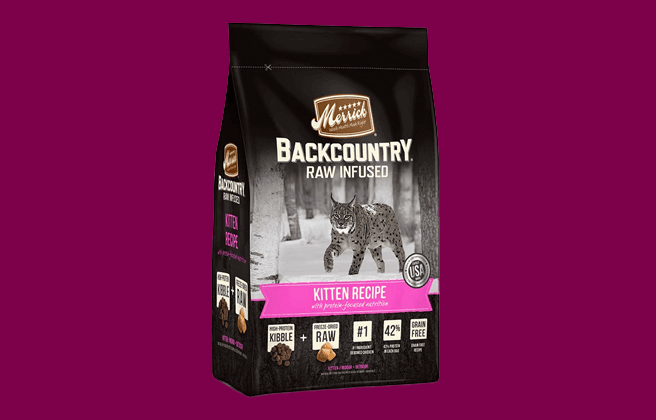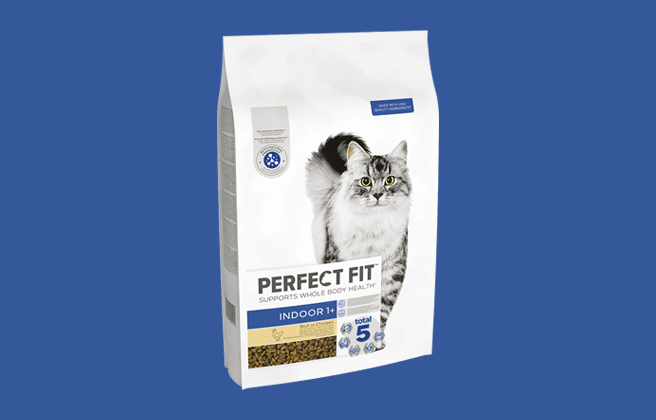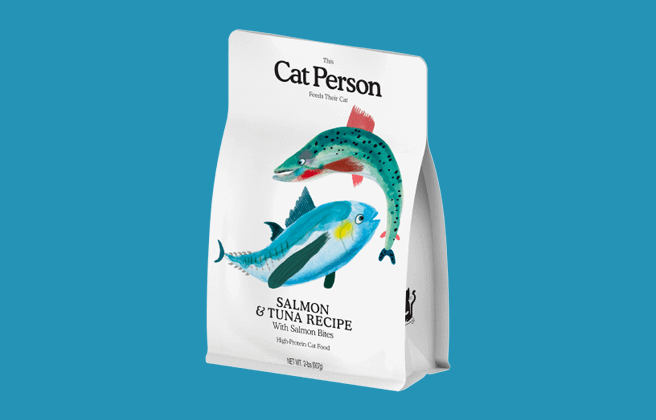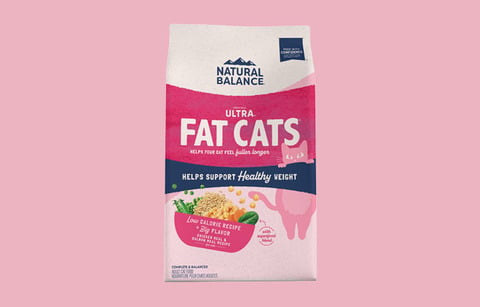
Our Verdict
Natural Balance Fat Cats dry cat food receives the Cat Food Advisor rating, 3 stars.
This food is formulated with antioxidants, vitamins and minerals to help maintain a healthy immune system.
Pros
- Relatively high in protein
- Contains antioxidant vitamins and minerals
- Omega-3
- High in fiber
Cons
- High in carbohydrates
- Contains plant based protein
- Only one recipe in the range
The table below shows each recipe in this range including our rating and the AAFCO nutrient profile: Growth (kitten), Maintenance (adult), All Life Stages, Supplemental or Unspecified.
| Product line | Rating | AAFCO |
|---|---|---|
| Fat Cats Chicken Meal & Salmon Meal Recipe | 3 | M |
Save up to 35%
with Autoship
See discount in cart
Recipe and Label Analysis
Label and nutrient data below are calculated using dry matter basis.
Fat Cats Chicken Meal & Salmon Meal Recipe
Estimated Dry Matter Nutrient Content
Protein
Fat
CarbsCarbohydrates
Chicken meal, salmon meal, pea protein, chickpeas, oat groats, peas, pea fiber, dried plain beet pulp, dehydrated alfalfa meal, oat hulls, dried tomato pomace, chicken fat preserved with mixed tocopherols), natural flavor, brewers dried yeast, dried egg product, salmon oil (preserved with mixed tocopherols), spinach, parsley, carrots, choline chloride, salt, potassium chloride, vitamins (vitamin E supplement, ascorbic acid, niacin supplement, vitamin A supplement, thiamine mononitrate, -calcium pantothenate, riboflavin supplement, pyridoxine hydrochloride, vitamin B12 supplement, folic acid, vitamin D3 supplement, biotin), minerals (zinc proteinate, zinc sulfate, ferrous sulfate, iron proteinate, copper sulfate, copper proteinate, sodium selenite, manganese sulfate, manganese proteinate, calcium iodate, inulin, ascorbyl 2-polyphosphate, demethionine, ecarnitine, taurine, e-lysine monohydrochloride, citric acid (preservative, mixed tocopherols (preservative), yucca schidigera extract, rosemary extract.
Fiber (estimated dry matter content) = 9%
Red denotes any controversial items
Ingredients Analysis
The first ingredient and second ingredients are chicken meal and salmon meal. Both are considered a meat concentrate and contain nearly 300% more protein than fresh chicken or fish.
Fish meal is typically obtained from the “clean, dried, ground tissue of undecomposed whole fish and fish cuttings” of commercial fish operations. 1
The third ingredient is pea protein, what remains of a pea after removing the starchy part of the vegetable.
Even though it contains over 80% protein, this ingredient would be expected to have a lower biological value than meat.
And less costly plant-based products like this can notably boost the total protein reported on the label — a factor that must be considered when judging the meat content of this cat food.
The fourth ingredient is chickpeas, also known as garbanzo beans. Like peas, beans and lentils, chickpea is a nutritious member of the fiber-rich legume (or pulse) family of vegetables.
However, chickpeas contain about 22% protein, a factor that must be considered when judging the actual meat content of this cat food.
The fifth ingredient is oat groats, a whole grain, minimally processed form of oats. With the exception of their caloric content and the fact they’re also gluten free, oat groats can be considered average in nutritional value.
The sixth ingredient is peas which are a quality source of carbohydrates. And like all legumes, they’re rich in natural fiber.
However, peas contain about 25% protein, a factor that must be considered when judging the meat content of this cat food.
The seventh ingredient is pea fiber, a mixture of both soluble and insoluble dietary fiber derived from pea hulls. Aside from the usual benefits of fiber, this agricultural by-product provides no other nutritional value to a cat.
The eighth ingredient is dried plain beet pulp. Beet pulp is a controversial ingredient, a high fiber by-product of sugar beet processing.
Some denounce beet pulp as an inexpensive filler while others cite its outstanding intestinal health and blood sugar benefits.
We only call your attention here to the controversy and believe the inclusion of beet pulp in reasonable amounts in most cat foods is entirely acceptable.
From here the list goes on to include a number of other items. But to be realistic, ingredients located this far down the list (other than nutritional supplements) are not likely to affect the overall rating of the product.
However this recipe contains brewers dried yeast, which can be a controversial item. Although it’s a by-product of the beer making process, this ingredient is rich in minerals and other healthy nutrients.
Fans believe yeast repels fleas and supports the immune system.
Critics argue yeast ingredients can be linked to allergies. This may be true, but (like all allergies) only if your particular cat is allergic to the yeast itself.
In any case, unless your cat is specifically allergic to it, yeast can still be considered a nutritious additive.
What’s more noteworthy here is that brewers yeast contains about 48% protein, a factor that must be considered when judging the actual meat content of this cat food.
Save up to 35%
with Autoship
See discount in cart
Nutrient Analysis
Based on its ingredients alone, Fat Cats Chicken Meal & Salmon Meal Recipe looks like an average dry product.
The dashboard displays a dry matter protein reading of 38.9%, a fat level of 10.6% and an estimated carbohydrate level of 42.6%.
As a group, the brand features a near-average protein content of 38.9% and a near-average fat level of 10.6%. Together these figures suggest a carbohydrate content of 42.6% for the overall product line, alongside a fat to protein ratio of 27%.
Final Word
This range of food derives the bulk of its protein from a mixture of animal and fish meal, although plant-based proteins are included. Overall, this food provides a balanced diet.
Has Natural Balance Fat Cats cat food been recalled in the past?
Yes, there have been three recorded recalls for Natural Balance.
In April 2007, the company informed the U.S. Food and Drug Administration of complaints it had received about its Venison & Brown Rice Dry Dog Food and Venison & Green Pea Dry Cat Food. According to these complaints, some pets had experienced vomiting and kidney failure after consuming these products due to trace amounts of melamine, which is thought to have come from rice concentrate.
Later that month, Natural Balance issued a second limited recall for four canned pet foods that were found to contain traces of melamine in rice protein concentrates.
In July 2007, the company recalled a small batch of canned pet food that it feared may have been contaminated in a large-scale botulism outbreak associated with one of its producers, Castleberry’s Food Company.
On July 3, 2020, Natural Balance’s parent company, J.M. Smucker, issued a voluntary recall on a single batch of Natural Balance Ultra Premium Chicken & Chicken Liver Pâté Formula, after receiving complaints that several cats had become unwell after eating it.
Subsequent tests revealed that the batch contained elevated levels of choline chloride.
You can view a complete list of all cat food recalls since 2021 here.
To stay on top of any cat food product recalls, sign up for our free email alerts, here.
About
Natural Balance Pet Foods was formed in 1989, and was sold in Petco’s 625 stores across the United States. In May 2013, Natural Balance merged with Del Monte Foods and was then sold again in 2015 to J.M Smucker Company.
Natural Balance headquarters are in Pacoima, Los Angeles, California. Its products are produced at a variety of manufacturers across the United States from ingredients sourced from the United States, France, India, New Zealand, and Canada.
Best cat foods
We uphold the highest editorial standards when creating the authoritative content pet parents rely on and trust.
Every piece of clinical content on the Cat Food Advisor is reviewed by our certified Veterinary Advisory Board, which consists of licensed veterinarians and medically certified specialists.
Our reviews are completely independent; we are not paid by any pet food company to promote their products favorably. We do not accept money, gifts, samples or other incentives in exchange for special consideration. For more information see our Disclaimer & Disclosure page.






